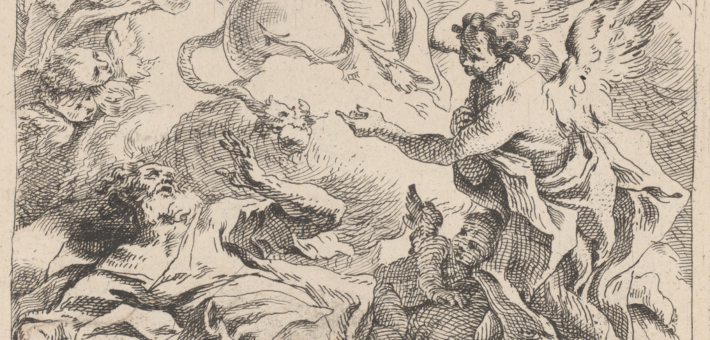Commentary on Matthew 1:18-25
The Gospel of Matthew begins with a titular sentence (1:1), which calls the account the “Book of Genesis” (Greek word meaning origin, beginning, birth, generation, creation, et cetera) of Jesus Christ. Here, Matthew uses the same Greek word, genesis, as the title of the first book of the Pentateuch in the Septuagint. It is possible, if not provable, that Matthew’s choice of this word is to present the biography of Jesus as if it is a new beginning at the cosmic level, comparable to the creation of the universe.
After the genealogy of Jesus from Abraham through Joseph (verses 2–17), Matthew sets out to tell the story of the birth (genesis: the same Greek word as in verse 1) of Jesus in today’s passage, which is the Matthean version of the annunciation and the virgin birth combined.
Unlike its Lukan counterpart, this passage has Joseph rather than Mary as the recipient of the annunciation. According to verse 18, before the betrothed couple lived together, Mary was found to be pregnant from the Holy Spirit. The text does not say whether Mary had previously known the conception was from the Holy Spirit, but it is clear that when her pregnancy was revealed to Joseph, he did not know this.
Probably assuming Mary had committed adultery, he intends to dismiss (in other words, divorce) her in secret, not wishing to disclose her shame publicly. Matthew calls such intent of Joseph just/righteous (verse 19), in that he chose not to follow the harsh punitive measures for adultery prescribed in the laws but to be merciful to his betrothed partner, whom he thought was unfaithful.
Then, the annunciation of an angel of the Lord came to Joseph, revealing to him that the child in Mary’s womb was from the Holy Spirit. The angel also told Joseph to name the child Iesus, a Greek transliteration of the Hebrew Yeshua/Yehoshua, meaning “Yahweh saves/is salvation.” This was a fairly common name among Jews during the Second Temple period, expressing their wishes and prayers for God’s deliverance from their current calamities, including oppression by the colonizing empires.
In our passage, the salvation by Jesus is further specified as “from their sins” (hamartiai). This should not be taken as evidence for the atonement theology of penal substitution, which is not clearly articulated in Matthew’s gospel. Rather, this reference to “sins” reflects Matthew’s adaptation of the Deuteronomistic theology of reward and punishment according to the deeds of the people of Israel, which interprets the conquest of Jerusalem by the Babylonian Empire and its lasting consequences as God’s punishment for the sins of Israel.
After narrating how the dream-revelation came to Joseph, Matthew provides his interpretive commentary using the so-called fulfilment formula, “All this took place to fulfill…” and providing a citation of Isaiah 7:14, which was originally an oracle of prophecy given to Ahaz, the sitting king of Judah, about the conception and birth of the future crown prince (in other words, Hezekiah) for the dynastic succession.
The Hebrew word used in the Masoretic Text is ‘almah, which means “young woman,” while Hebrew has a different noun, bethulah, for “virgin.” Matthew seems to follow the Septuagint translation that uses parthenos, which means “virgin.”1 Regardless of the original meaning of Isaiah 7:14 in its eighth-century BCE context, it efficiently serves Matthew’s theological understanding of the Jesus event as the fulfillment of the Hebrew Bible prophecies.
The name of the soon-to-be newborn prince in Isaiah 7:14 is Immanu-El, which is a Hebrew phrase meaning “God with us.” As such, it reflects Isaiah’s oracular vision for the abiding presence of God in Judah in the midst of the national crisis caused by the threat from the Assyrian Empire, even as Ahaz wanted to capitulate to Tiglath-Pileser III of Assyria.
During the time of Jesus and also the time of the composition of the Gospel of Matthew, Israel’s sovereignty had not been restored, as they were living under the colonial power of the Roman Empire. The birth of Jesus as one who personifies the salvation and abiding presence of God for the people of Israel will rekindle the same kind of communal hope for deliverance by God as was promised by the oracle of Isaiah.
Verse 24 provides a brief statement of Joseph’s obedient act of taking Mary as his wife but “not knowing her” (Hebrew euphemism for sexual intercourse), apparently to keep Mary’s virginity until she gave birth to Jesus. Matthew simply says so without dwelling on the fine difference between virginal conception and virgin birth. What matters to Matthew is the recognition of the divine origin, hence the divine sonship, of Jesus.
The last sentence (verse 25) presents Joseph naming the child “Jesus,” as he was commanded by the angel. This naming act solves the problem of how Jesus could be called “Son of David” in Matthew’s narrative world since he has nothing to do with Joseph, biologically speaking, and therefore does not share Joseph’s royal lineage of the Davidic dynasty.
In this story, Joseph gives a name to the child of his wife, and by doing so, he symbolically, if not formally, adopts him as his own. That is, in the Gospel of Matthew, Jesus is a natural son of God and an adopted son of Joseph. In that capacity, he is a legitimate “Son of David,” which was a messianic title among the Jews at that time.
Notes
- It is not impossible that the original Septuagint had neanis (“young woman”) and that parthenos (“virgin”) is a textual variant caused by a later Christian scribal substitution influenced by the virgin birth theology, as the Jewish editions of the Septuagint (for example, Aquila, Symmachus, and Theodotion) have neanis instead of parthenos.



December 21, 2025